Sexual Assault: Issues, Rules, and Application
VerifiedAdded on 2022/11/26
|8
|1539
|390
AI Summary
This document discusses the issues, rules, and application of sexual assault cases. It explores the elements of section 61I of the Crime Act 1990 (NSW) and analyzes the concept of consent in relation to sexual activity. The document also examines the need for law reform in cases of sexual offences.
Contribute Materials
Your contribution can guide someone’s learning journey. Share your
documents today.
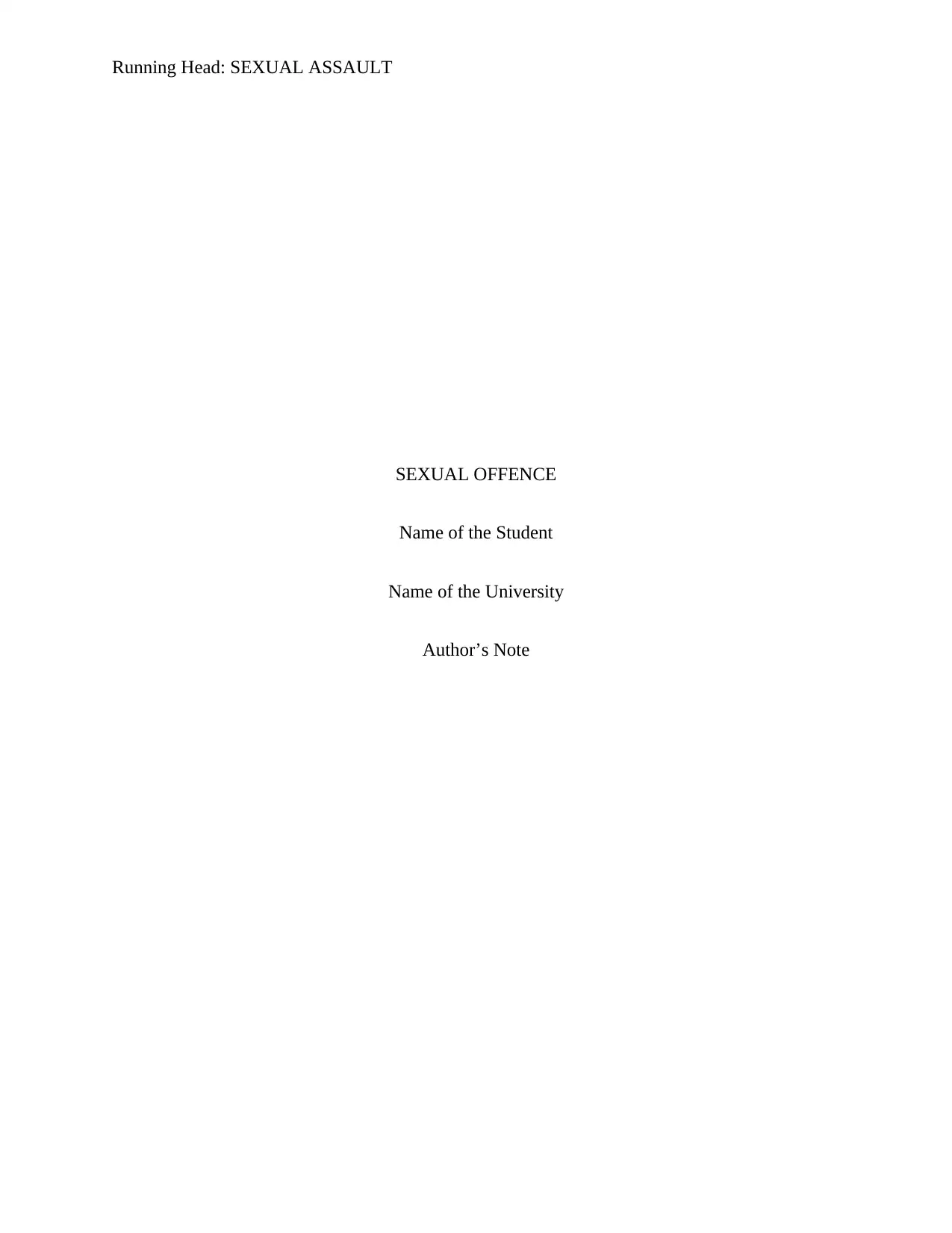
Running Head: SEXUAL ASSAULT
SEXUAL OFFENCE
Name of the Student
Name of the University
Author’s Note
SEXUAL OFFENCE
Name of the Student
Name of the University
Author’s Note
Secure Best Marks with AI Grader
Need help grading? Try our AI Grader for instant feedback on your assignments.
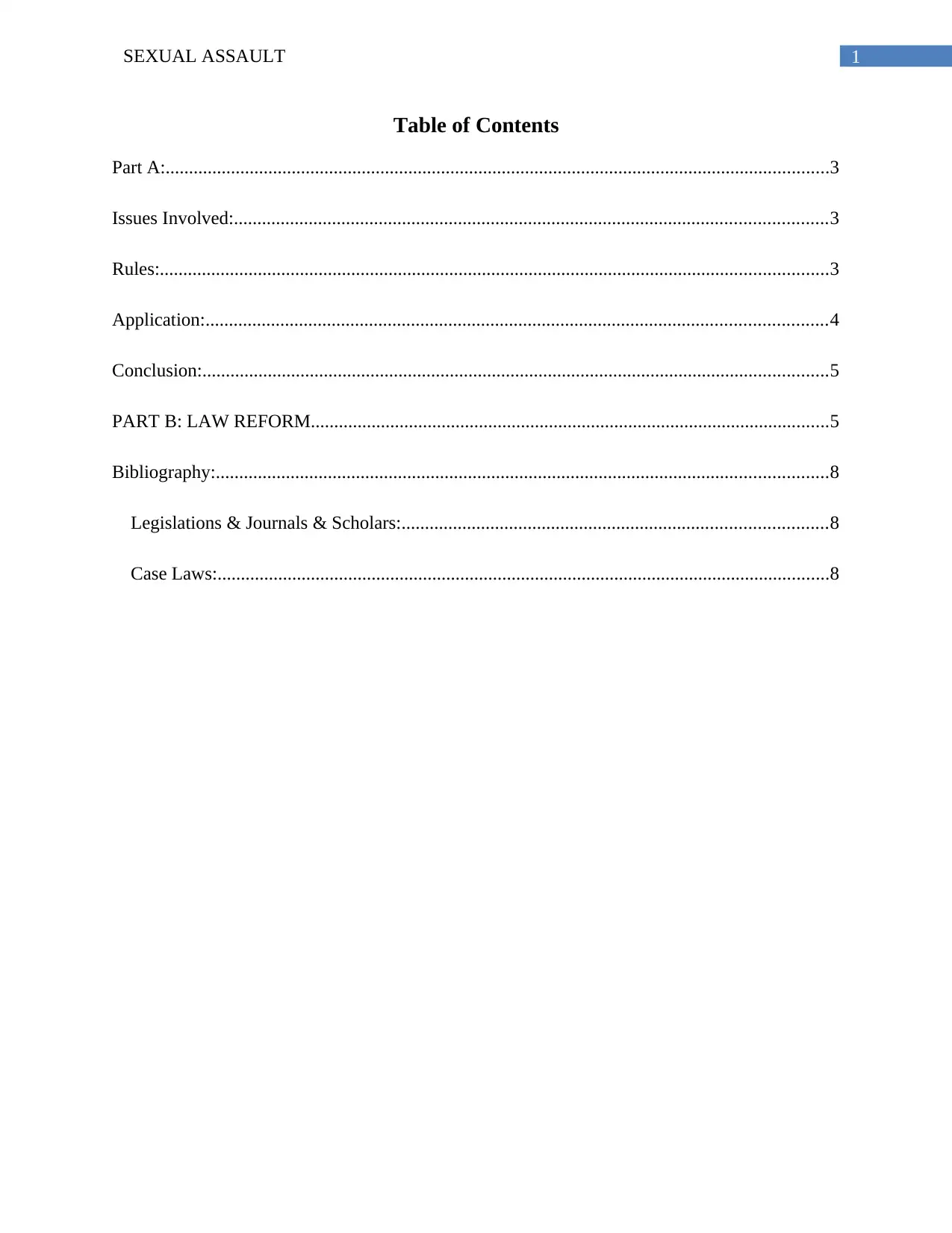
1SEXUAL ASSAULT
Table of Contents
Part A:..............................................................................................................................................3
Issues Involved:...............................................................................................................................3
Rules:...............................................................................................................................................3
Application:.....................................................................................................................................4
Conclusion:......................................................................................................................................5
PART B: LAW REFORM...............................................................................................................5
Bibliography:...................................................................................................................................8
Legislations & Journals & Scholars:...........................................................................................8
Case Laws:...................................................................................................................................8
Table of Contents
Part A:..............................................................................................................................................3
Issues Involved:...............................................................................................................................3
Rules:...............................................................................................................................................3
Application:.....................................................................................................................................4
Conclusion:......................................................................................................................................5
PART B: LAW REFORM...............................................................................................................5
Bibliography:...................................................................................................................................8
Legislations & Journals & Scholars:...........................................................................................8
Case Laws:...................................................................................................................................8
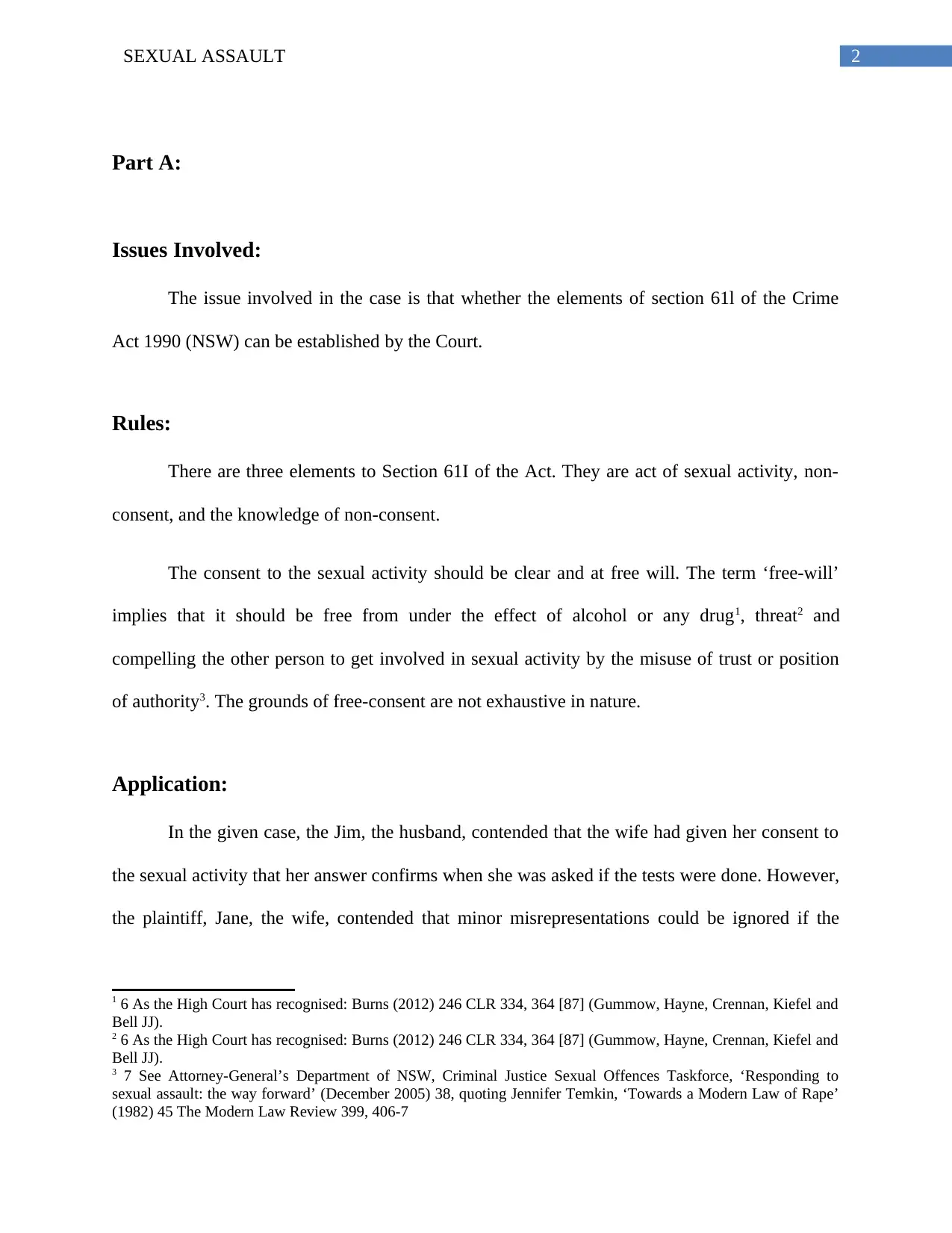
2SEXUAL ASSAULT
Part A:
Issues Involved:
The issue involved in the case is that whether the elements of section 61l of the Crime
Act 1990 (NSW) can be established by the Court.
Rules:
There are three elements to Section 61I of the Act. They are act of sexual activity, non-
consent, and the knowledge of non-consent.
The consent to the sexual activity should be clear and at free will. The term ‘free-will’
implies that it should be free from under the effect of alcohol or any drug1, threat2 and
compelling the other person to get involved in sexual activity by the misuse of trust or position
of authority3. The grounds of free-consent are not exhaustive in nature.
Application:
In the given case, the Jim, the husband, contended that the wife had given her consent to
the sexual activity that her answer confirms when she was asked if the tests were done. However,
the plaintiff, Jane, the wife, contended that minor misrepresentations could be ignored if the
1 6 As the High Court has recognised: Burns (2012) 246 CLR 334, 364 [87] (Gummow, Hayne, Crennan, Kiefel and
Bell JJ).
2 6 As the High Court has recognised: Burns (2012) 246 CLR 334, 364 [87] (Gummow, Hayne, Crennan, Kiefel and
Bell JJ).
3 7 See Attorney-General’s Department of NSW, Criminal Justice Sexual Offences Taskforce, ‘Responding to
sexual assault: the way forward’ (December 2005) 38, quoting Jennifer Temkin, ‘Towards a Modern Law of Rape’
(1982) 45 The Modern Law Review 399, 406-7
Part A:
Issues Involved:
The issue involved in the case is that whether the elements of section 61l of the Crime
Act 1990 (NSW) can be established by the Court.
Rules:
There are three elements to Section 61I of the Act. They are act of sexual activity, non-
consent, and the knowledge of non-consent.
The consent to the sexual activity should be clear and at free will. The term ‘free-will’
implies that it should be free from under the effect of alcohol or any drug1, threat2 and
compelling the other person to get involved in sexual activity by the misuse of trust or position
of authority3. The grounds of free-consent are not exhaustive in nature.
Application:
In the given case, the Jim, the husband, contended that the wife had given her consent to
the sexual activity that her answer confirms when she was asked if the tests were done. However,
the plaintiff, Jane, the wife, contended that minor misrepresentations could be ignored if the
1 6 As the High Court has recognised: Burns (2012) 246 CLR 334, 364 [87] (Gummow, Hayne, Crennan, Kiefel and
Bell JJ).
2 6 As the High Court has recognised: Burns (2012) 246 CLR 334, 364 [87] (Gummow, Hayne, Crennan, Kiefel and
Bell JJ).
3 7 See Attorney-General’s Department of NSW, Criminal Justice Sexual Offences Taskforce, ‘Responding to
sexual assault: the way forward’ (December 2005) 38, quoting Jennifer Temkin, ‘Towards a Modern Law of Rape’
(1982) 45 The Modern Law Review 399, 406-7
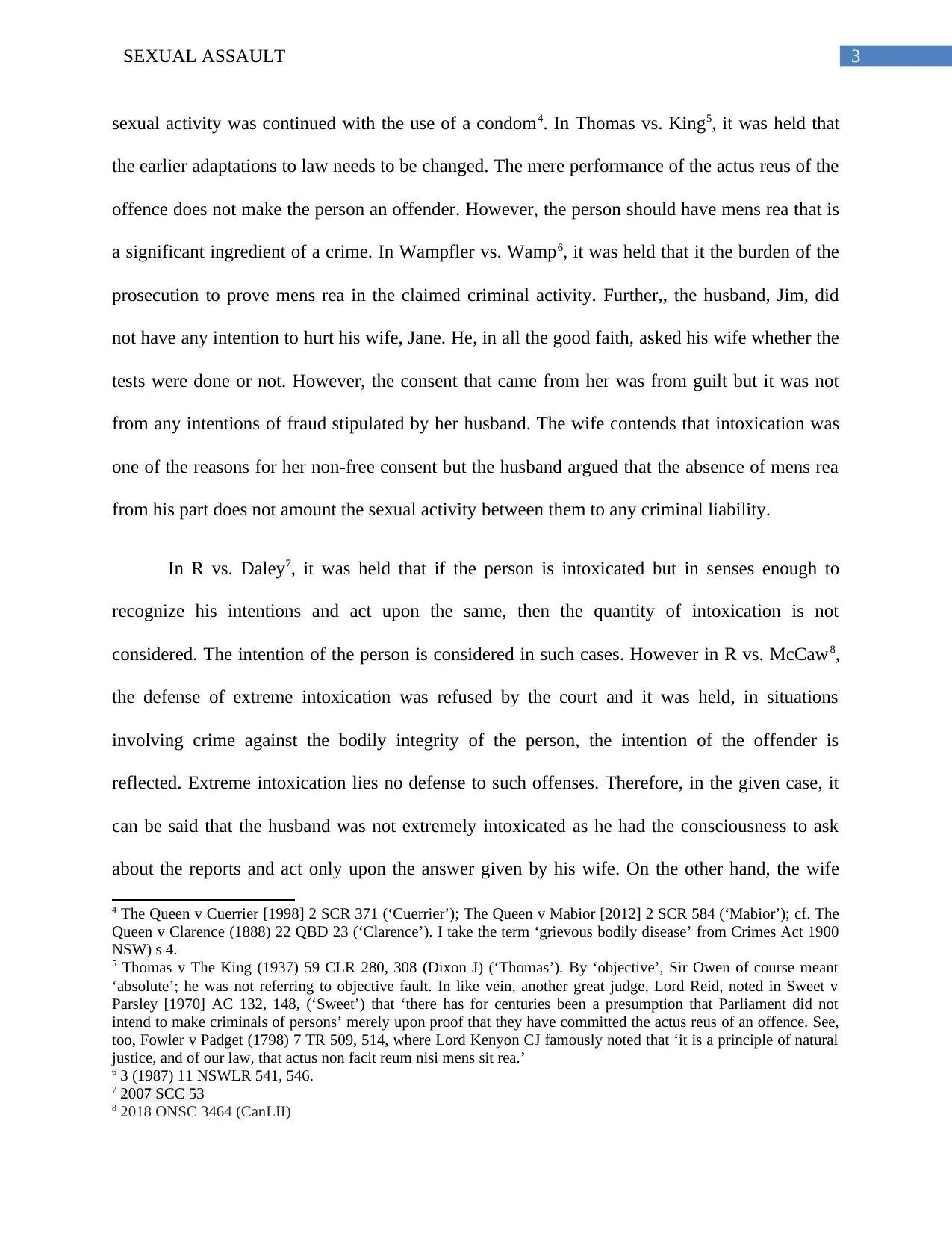
3SEXUAL ASSAULT
sexual activity was continued with the use of a condom4. In Thomas vs. King5, it was held that
the earlier adaptations to law needs to be changed. The mere performance of the actus reus of the
offence does not make the person an offender. However, the person should have mens rea that is
a significant ingredient of a crime. In Wampfler vs. Wamp6, it was held that it the burden of the
prosecution to prove mens rea in the claimed criminal activity. Further,, the husband, Jim, did
not have any intention to hurt his wife, Jane. He, in all the good faith, asked his wife whether the
tests were done or not. However, the consent that came from her was from guilt but it was not
from any intentions of fraud stipulated by her husband. The wife contends that intoxication was
one of the reasons for her non-free consent but the husband argued that the absence of mens rea
from his part does not amount the sexual activity between them to any criminal liability.
In R vs. Daley7, it was held that if the person is intoxicated but in senses enough to
recognize his intentions and act upon the same, then the quantity of intoxication is not
considered. The intention of the person is considered in such cases. However in R vs. McCaw8,
the defense of extreme intoxication was refused by the court and it was held, in situations
involving crime against the bodily integrity of the person, the intention of the offender is
reflected. Extreme intoxication lies no defense to such offenses. Therefore, in the given case, it
can be said that the husband was not extremely intoxicated as he had the consciousness to ask
about the reports and act only upon the answer given by his wife. On the other hand, the wife
4 The Queen v Cuerrier [1998] 2 SCR 371 (‘Cuerrier’); The Queen v Mabior [2012] 2 SCR 584 (‘Mabior’); cf. The
Queen v Clarence (1888) 22 QBD 23 (‘Clarence’). I take the term ‘grievous bodily disease’ from Crimes Act 1900
NSW) s 4.
5 Thomas v The King (1937) 59 CLR 280, 308 (Dixon J) (‘Thomas’). By ‘objective’, Sir Owen of course meant
‘absolute’; he was not referring to objective fault. In like vein, another great judge, Lord Reid, noted in Sweet v
Parsley [1970] AC 132, 148, (‘Sweet’) that ‘there has for centuries been a presumption that Parliament did not
intend to make criminals of persons’ merely upon proof that they have committed the actus reus of an offence. See,
too, Fowler v Padget (1798) 7 TR 509, 514, where Lord Kenyon CJ famously noted that ‘it is a principle of natural
justice, and of our law, that actus non facit reum nisi mens sit rea.’
6 3 (1987) 11 NSWLR 541, 546.
7 2007 SCC 53
8 2018 ONSC 3464 (CanLII)
sexual activity was continued with the use of a condom4. In Thomas vs. King5, it was held that
the earlier adaptations to law needs to be changed. The mere performance of the actus reus of the
offence does not make the person an offender. However, the person should have mens rea that is
a significant ingredient of a crime. In Wampfler vs. Wamp6, it was held that it the burden of the
prosecution to prove mens rea in the claimed criminal activity. Further,, the husband, Jim, did
not have any intention to hurt his wife, Jane. He, in all the good faith, asked his wife whether the
tests were done or not. However, the consent that came from her was from guilt but it was not
from any intentions of fraud stipulated by her husband. The wife contends that intoxication was
one of the reasons for her non-free consent but the husband argued that the absence of mens rea
from his part does not amount the sexual activity between them to any criminal liability.
In R vs. Daley7, it was held that if the person is intoxicated but in senses enough to
recognize his intentions and act upon the same, then the quantity of intoxication is not
considered. The intention of the person is considered in such cases. However in R vs. McCaw8,
the defense of extreme intoxication was refused by the court and it was held, in situations
involving crime against the bodily integrity of the person, the intention of the offender is
reflected. Extreme intoxication lies no defense to such offenses. Therefore, in the given case, it
can be said that the husband was not extremely intoxicated as he had the consciousness to ask
about the reports and act only upon the answer given by his wife. On the other hand, the wife
4 The Queen v Cuerrier [1998] 2 SCR 371 (‘Cuerrier’); The Queen v Mabior [2012] 2 SCR 584 (‘Mabior’); cf. The
Queen v Clarence (1888) 22 QBD 23 (‘Clarence’). I take the term ‘grievous bodily disease’ from Crimes Act 1900
NSW) s 4.
5 Thomas v The King (1937) 59 CLR 280, 308 (Dixon J) (‘Thomas’). By ‘objective’, Sir Owen of course meant
‘absolute’; he was not referring to objective fault. In like vein, another great judge, Lord Reid, noted in Sweet v
Parsley [1970] AC 132, 148, (‘Sweet’) that ‘there has for centuries been a presumption that Parliament did not
intend to make criminals of persons’ merely upon proof that they have committed the actus reus of an offence. See,
too, Fowler v Padget (1798) 7 TR 509, 514, where Lord Kenyon CJ famously noted that ‘it is a principle of natural
justice, and of our law, that actus non facit reum nisi mens sit rea.’
6 3 (1987) 11 NSWLR 541, 546.
7 2007 SCC 53
8 2018 ONSC 3464 (CanLII)
Secure Best Marks with AI Grader
Need help grading? Try our AI Grader for instant feedback on your assignments.
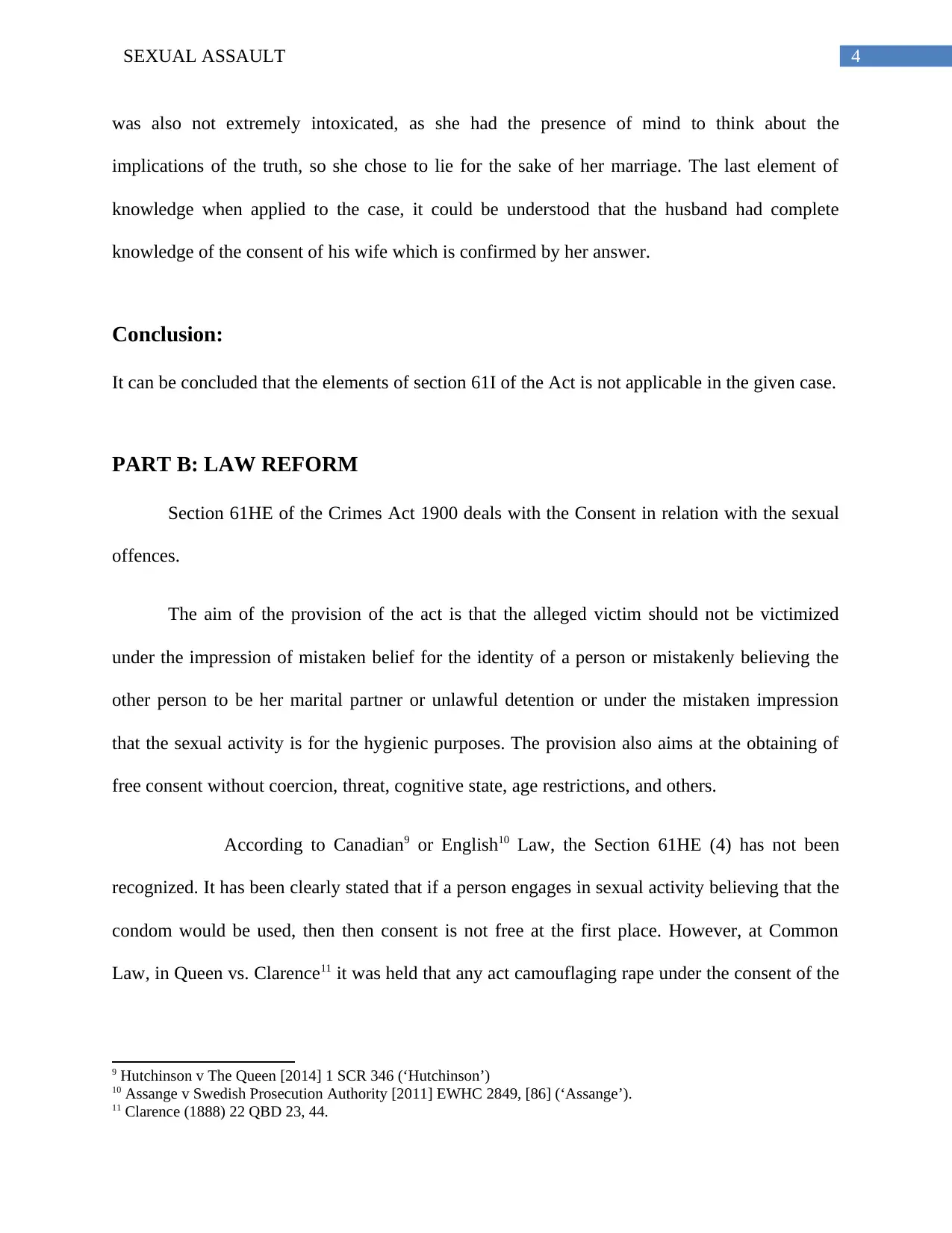
4SEXUAL ASSAULT
was also not extremely intoxicated, as she had the presence of mind to think about the
implications of the truth, so she chose to lie for the sake of her marriage. The last element of
knowledge when applied to the case, it could be understood that the husband had complete
knowledge of the consent of his wife which is confirmed by her answer.
Conclusion:
It can be concluded that the elements of section 61I of the Act is not applicable in the given case.
PART B: LAW REFORM
Section 61HE of the Crimes Act 1900 deals with the Consent in relation with the sexual
offences.
The aim of the provision of the act is that the alleged victim should not be victimized
under the impression of mistaken belief for the identity of a person or mistakenly believing the
other person to be her marital partner or unlawful detention or under the mistaken impression
that the sexual activity is for the hygienic purposes. The provision also aims at the obtaining of
free consent without coercion, threat, cognitive state, age restrictions, and others.
According to Canadian9 or English10 Law, the Section 61HE (4) has not been
recognized. It has been clearly stated that if a person engages in sexual activity believing that the
condom would be used, then then consent is not free at the first place. However, at Common
Law, in Queen vs. Clarence11 it was held that any act camouflaging rape under the consent of the
9 Hutchinson v The Queen [2014] 1 SCR 346 (‘Hutchinson’)
10 Assange v Swedish Prosecution Authority [2011] EWHC 2849, [86] (‘Assange’).
11 Clarence (1888) 22 QBD 23, 44.
was also not extremely intoxicated, as she had the presence of mind to think about the
implications of the truth, so she chose to lie for the sake of her marriage. The last element of
knowledge when applied to the case, it could be understood that the husband had complete
knowledge of the consent of his wife which is confirmed by her answer.
Conclusion:
It can be concluded that the elements of section 61I of the Act is not applicable in the given case.
PART B: LAW REFORM
Section 61HE of the Crimes Act 1900 deals with the Consent in relation with the sexual
offences.
The aim of the provision of the act is that the alleged victim should not be victimized
under the impression of mistaken belief for the identity of a person or mistakenly believing the
other person to be her marital partner or unlawful detention or under the mistaken impression
that the sexual activity is for the hygienic purposes. The provision also aims at the obtaining of
free consent without coercion, threat, cognitive state, age restrictions, and others.
According to Canadian9 or English10 Law, the Section 61HE (4) has not been
recognized. It has been clearly stated that if a person engages in sexual activity believing that the
condom would be used, then then consent is not free at the first place. However, at Common
Law, in Queen vs. Clarence11 it was held that any act camouflaging rape under the consent of the
9 Hutchinson v The Queen [2014] 1 SCR 346 (‘Hutchinson’)
10 Assange v Swedish Prosecution Authority [2011] EWHC 2849, [86] (‘Assange’).
11 Clarence (1888) 22 QBD 23, 44.
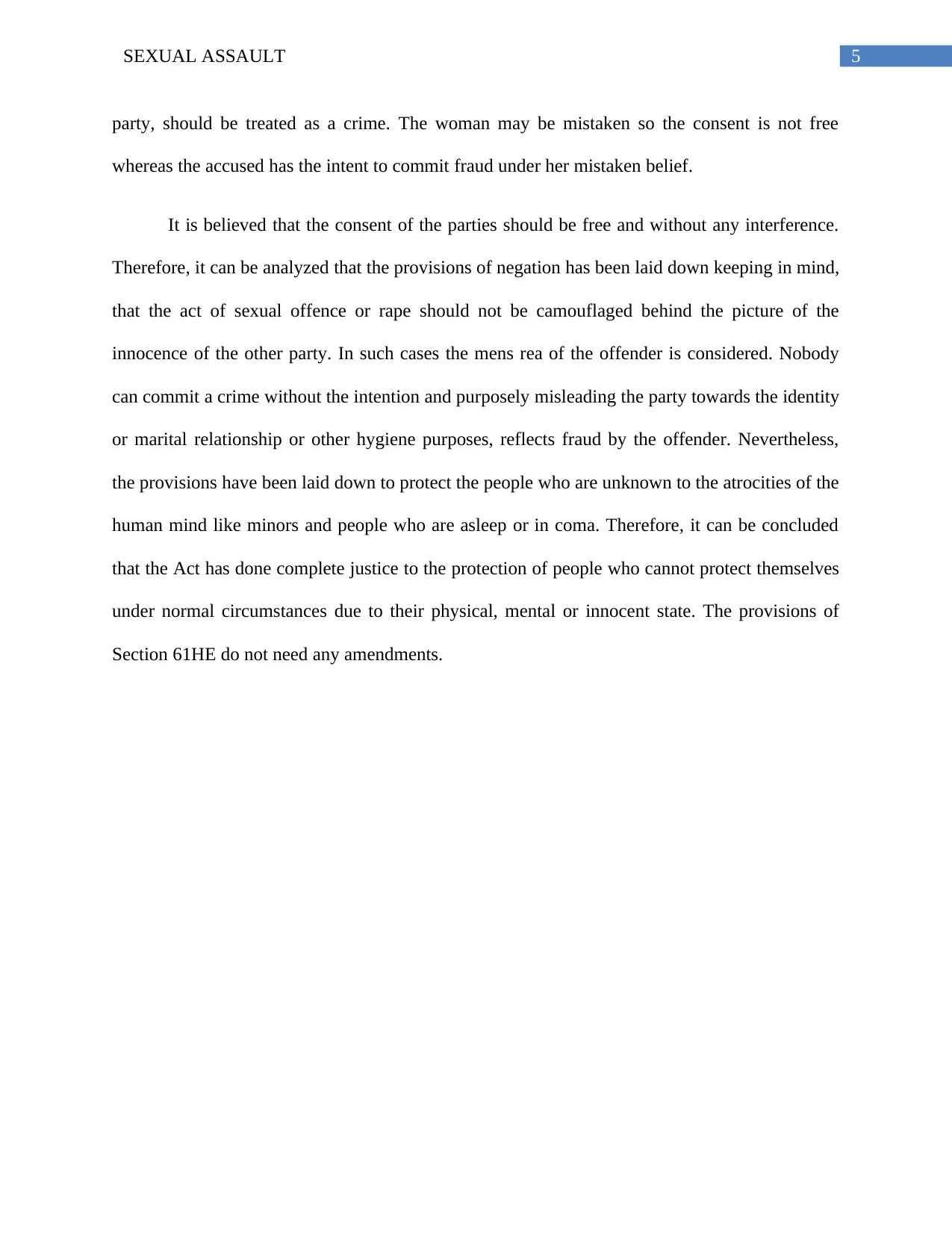
5SEXUAL ASSAULT
party, should be treated as a crime. The woman may be mistaken so the consent is not free
whereas the accused has the intent to commit fraud under her mistaken belief.
It is believed that the consent of the parties should be free and without any interference.
Therefore, it can be analyzed that the provisions of negation has been laid down keeping in mind,
that the act of sexual offence or rape should not be camouflaged behind the picture of the
innocence of the other party. In such cases the mens rea of the offender is considered. Nobody
can commit a crime without the intention and purposely misleading the party towards the identity
or marital relationship or other hygiene purposes, reflects fraud by the offender. Nevertheless,
the provisions have been laid down to protect the people who are unknown to the atrocities of the
human mind like minors and people who are asleep or in coma. Therefore, it can be concluded
that the Act has done complete justice to the protection of people who cannot protect themselves
under normal circumstances due to their physical, mental or innocent state. The provisions of
Section 61HE do not need any amendments.
party, should be treated as a crime. The woman may be mistaken so the consent is not free
whereas the accused has the intent to commit fraud under her mistaken belief.
It is believed that the consent of the parties should be free and without any interference.
Therefore, it can be analyzed that the provisions of negation has been laid down keeping in mind,
that the act of sexual offence or rape should not be camouflaged behind the picture of the
innocence of the other party. In such cases the mens rea of the offender is considered. Nobody
can commit a crime without the intention and purposely misleading the party towards the identity
or marital relationship or other hygiene purposes, reflects fraud by the offender. Nevertheless,
the provisions have been laid down to protect the people who are unknown to the atrocities of the
human mind like minors and people who are asleep or in coma. Therefore, it can be concluded
that the Act has done complete justice to the protection of people who cannot protect themselves
under normal circumstances due to their physical, mental or innocent state. The provisions of
Section 61HE do not need any amendments.
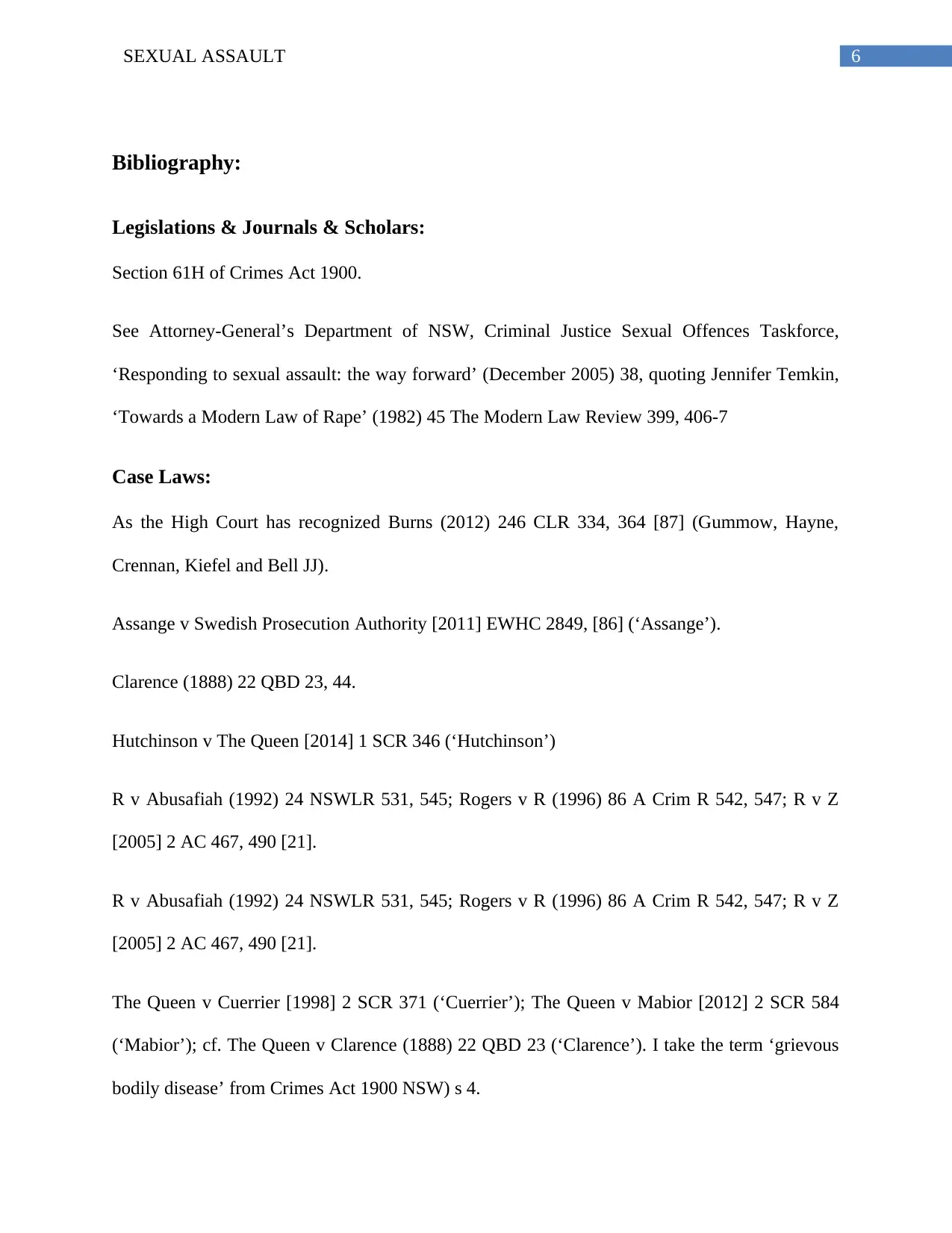
6SEXUAL ASSAULT
Bibliography:
Legislations & Journals & Scholars:
Section 61H of Crimes Act 1900.
See Attorney-General’s Department of NSW, Criminal Justice Sexual Offences Taskforce,
‘Responding to sexual assault: the way forward’ (December 2005) 38, quoting Jennifer Temkin,
‘Towards a Modern Law of Rape’ (1982) 45 The Modern Law Review 399, 406-7
Case Laws:
As the High Court has recognized Burns (2012) 246 CLR 334, 364 [87] (Gummow, Hayne,
Crennan, Kiefel and Bell JJ).
Assange v Swedish Prosecution Authority [2011] EWHC 2849, [86] (‘Assange’).
Clarence (1888) 22 QBD 23, 44.
Hutchinson v The Queen [2014] 1 SCR 346 (‘Hutchinson’)
R v Abusafiah (1992) 24 NSWLR 531, 545; Rogers v R (1996) 86 A Crim R 542, 547; R v Z
[2005] 2 AC 467, 490 [21].
R v Abusafiah (1992) 24 NSWLR 531, 545; Rogers v R (1996) 86 A Crim R 542, 547; R v Z
[2005] 2 AC 467, 490 [21].
The Queen v Cuerrier [1998] 2 SCR 371 (‘Cuerrier’); The Queen v Mabior [2012] 2 SCR 584
(‘Mabior’); cf. The Queen v Clarence (1888) 22 QBD 23 (‘Clarence’). I take the term ‘grievous
bodily disease’ from Crimes Act 1900 NSW) s 4.
Bibliography:
Legislations & Journals & Scholars:
Section 61H of Crimes Act 1900.
See Attorney-General’s Department of NSW, Criminal Justice Sexual Offences Taskforce,
‘Responding to sexual assault: the way forward’ (December 2005) 38, quoting Jennifer Temkin,
‘Towards a Modern Law of Rape’ (1982) 45 The Modern Law Review 399, 406-7
Case Laws:
As the High Court has recognized Burns (2012) 246 CLR 334, 364 [87] (Gummow, Hayne,
Crennan, Kiefel and Bell JJ).
Assange v Swedish Prosecution Authority [2011] EWHC 2849, [86] (‘Assange’).
Clarence (1888) 22 QBD 23, 44.
Hutchinson v The Queen [2014] 1 SCR 346 (‘Hutchinson’)
R v Abusafiah (1992) 24 NSWLR 531, 545; Rogers v R (1996) 86 A Crim R 542, 547; R v Z
[2005] 2 AC 467, 490 [21].
R v Abusafiah (1992) 24 NSWLR 531, 545; Rogers v R (1996) 86 A Crim R 542, 547; R v Z
[2005] 2 AC 467, 490 [21].
The Queen v Cuerrier [1998] 2 SCR 371 (‘Cuerrier’); The Queen v Mabior [2012] 2 SCR 584
(‘Mabior’); cf. The Queen v Clarence (1888) 22 QBD 23 (‘Clarence’). I take the term ‘grievous
bodily disease’ from Crimes Act 1900 NSW) s 4.
Paraphrase This Document
Need a fresh take? Get an instant paraphrase of this document with our AI Paraphraser
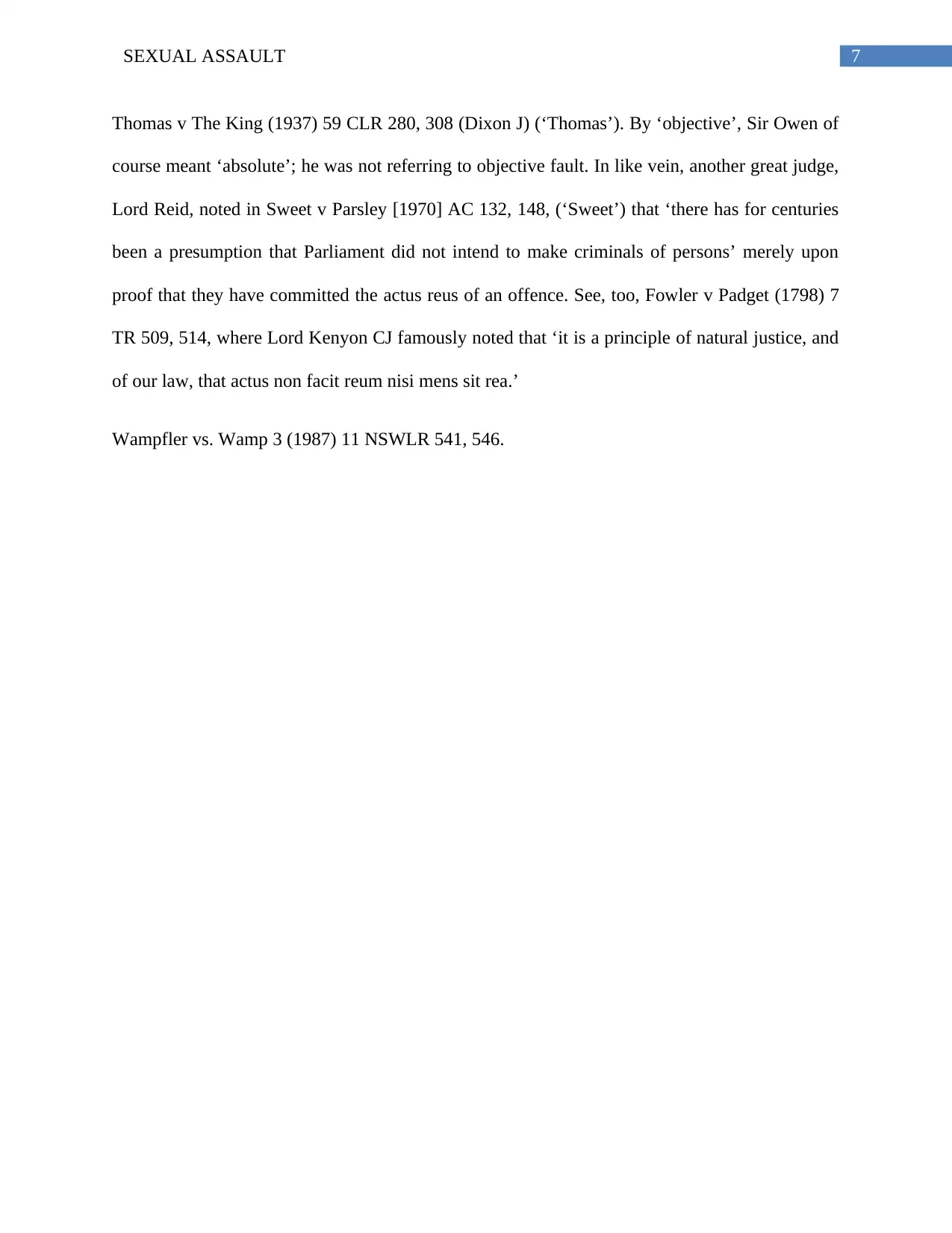
7SEXUAL ASSAULT
Thomas v The King (1937) 59 CLR 280, 308 (Dixon J) (‘Thomas’). By ‘objective’, Sir Owen of
course meant ‘absolute’; he was not referring to objective fault. In like vein, another great judge,
Lord Reid, noted in Sweet v Parsley [1970] AC 132, 148, (‘Sweet’) that ‘there has for centuries
been a presumption that Parliament did not intend to make criminals of persons’ merely upon
proof that they have committed the actus reus of an offence. See, too, Fowler v Padget (1798) 7
TR 509, 514, where Lord Kenyon CJ famously noted that ‘it is a principle of natural justice, and
of our law, that actus non facit reum nisi mens sit rea.’
Wampfler vs. Wamp 3 (1987) 11 NSWLR 541, 546.
Thomas v The King (1937) 59 CLR 280, 308 (Dixon J) (‘Thomas’). By ‘objective’, Sir Owen of
course meant ‘absolute’; he was not referring to objective fault. In like vein, another great judge,
Lord Reid, noted in Sweet v Parsley [1970] AC 132, 148, (‘Sweet’) that ‘there has for centuries
been a presumption that Parliament did not intend to make criminals of persons’ merely upon
proof that they have committed the actus reus of an offence. See, too, Fowler v Padget (1798) 7
TR 509, 514, where Lord Kenyon CJ famously noted that ‘it is a principle of natural justice, and
of our law, that actus non facit reum nisi mens sit rea.’
Wampfler vs. Wamp 3 (1987) 11 NSWLR 541, 546.
1 out of 8
Related Documents
Your All-in-One AI-Powered Toolkit for Academic Success.
+13062052269
info@desklib.com
Available 24*7 on WhatsApp / Email
![[object Object]](/_next/static/media/star-bottom.7253800d.svg)
Unlock your academic potential
© 2024 | Zucol Services PVT LTD | All rights reserved.





